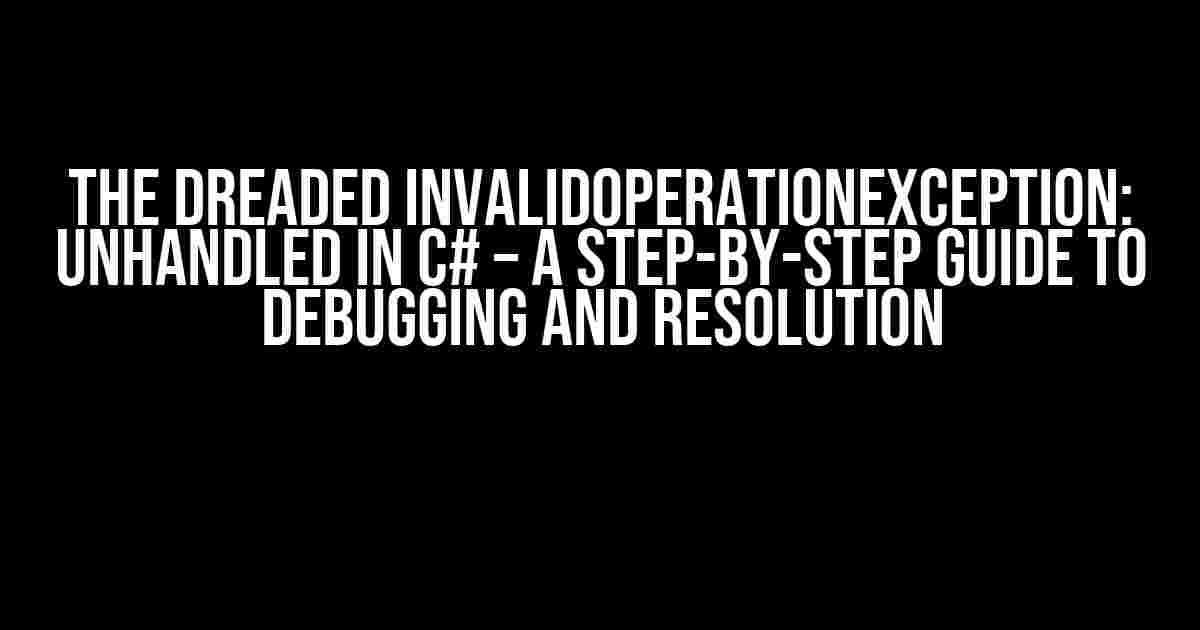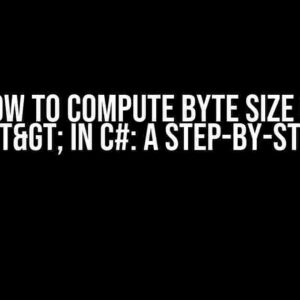Are you tired of staring at the soul-crushing error message “InvalidOperationException was unhandled” in your C# application? Do you feel like you’ve tried every trick in the book to fix the issue, but to no avail? Fear not, dear developer, for this article is here to guide you through the treacherous waters of debugging and resolution.
Understanding the Exception
An InvalidOperationException is thrown when a method call is invalid for the object’s current state. Think of it like trying to open a door that’s already open – it just doesn’t make sense. In C#, this exception is typically thrown when:
- A method is called on an object that is in an invalid state, such as calling
ToList()on a null collection. - A method is called on an object that is not yet initialized, such as trying to access a property of an object that has not been instantiated.
- A method is called with invalid or null parameters, such as passing a null string to a method that expects a valid string.
Common Scenarios That Trigger the Exception
Now that we’ve covered the basics, let’s dive into some common scenarios that might trigger the infamous “InvalidOperationException was unhandled” error message.
One of the most common causes of an InvalidOperationException is a null reference exception. This occurs when you’re trying to access a property or method of an object that is null.
string myString = null;
Console.WriteLine(myString.Length); // Boom! NullReferenceException
In this example, the Length property is being called on a null string, which throws a NullReferenceException. To fix this, simply check for null before accessing the property.
string myString = null;
if (myString != null)
{
Console.WriteLine(myString.Length);
}
Another common scenario is when an object is in an invalid operation state. For example:
List<string> myList = new List<string>();
myList.Add("Hello");
myList.Clear();
myList.Add("World"); // Boom! InvalidOperationException
In this example, the list is cleared after adding an item, and then trying to add another item to a cleared list throws an InvalidOperationException. To fix this, ensure that the object is in a valid state before performing operations on it.
List<string> myList = new List<string>();
myList.Add("Hello");
myList.Clear();
if (myList != null && myList.Count == 0)
{
myList.Add("World");
}
Debugging Techniques
Now that we’ve covered some common scenarios that trigger the exception, let’s discuss some essential debugging techniques to help you identify and fix the issue.
One of the most effective ways to debug an application is to set breakpoints and step-through the code line by line.
- Set a breakpoint on the line where the exception is thrown.
- Run the application in debug mode.
- When the breakpoint is hit, step-through the code line by line using F10 or F11.
- Examine the values of variables and objects to identify the source of the issue.
Visual Studio provides an exception settings feature that allows you to break on specific exceptions. To do this:
- Go to Debug > Windows > Exception Settings.
- In the Exception Settings window, check the box next to “Common Language Runtime Exceptions”.
- Check the box next to “InvalidOperationException” specifically.
- Click OK to save the changes.
Now, when an InvalidOperationException is thrown, the application will break and allow you to debug the issue.
Visual Studio provides an arsenal of debugging tools that can help you identify the issue. Some of the most useful tools include:
- The Immediate Window: allows you to execute code and evaluate expressions during debugging.
- The Watch Window: allows you to monitor the values of variables and objects during debugging.
- The Autos Window: displays the values of variables and objects used in the current line of code.
Best Practices for Avoiding the Exception
To avoid the “InvalidOperationException was unhandled” error message, follow these best practices:
Always perform null checks on objects before accessing their properties or methods.
string myString = null;
if (myString != null)
{
Console.WriteLine(myString.Length);
}
Ensure that objects are in a valid operation state before performing operations on them.
List<string> myList = new List<string>();
myList.Add("Hello");
if (myList != null && myList.Count > 0)
{
myList.Clear();
}
Implement robust error handling mechanisms to catch and handle exceptions gracefully.
try
{
// Code that might throw an exception
}
catch (InvalidOperationException ex)
{
Console.WriteLine("An invalid operation exception occurred: " + ex.Message);
}
Conclusion
In conclusion, the “InvalidOperationException was unhandled” error message in C# can be a daunting challenge to overcome. However, by understanding the exception, identifying common scenarios that trigger it, using effective debugging techniques, and following best practices, you can debug and resolve the issue with ease. Remember, a well-debugged application is a happy application!
| Scenario | Fix |
|---|---|
| NullReferenceException | Perform null checks on objects before accessing their properties or methods. |
| Invalid Operation State | Ensure that objects are in a valid operation state before performing operations on them. |
| Error Handling | Implement robust error handling mechanisms to catch and handle exceptions gracefully. |
By following these guidelines, you’ll be well on your way to becoming a master debugger and resolving the “InvalidOperationException was unhandled” error message with confidence.
Frequently Asked Question
User-oriented answers to the infamous “InvalidOperationException was unhandled” error in C# programming.
Q: What does the “InvalidOperationException was unhandled” error mean in C#?
A: The “InvalidOperationException was unhandled” error in C# indicates that a method or operation is being called when the object’s state is not valid or is in an invalid state. This typically occurs when a method is trying to perform an operation that’s not supported in its current state.
Q: What are the common causes of the “InvalidOperationException was unhandled” error in C#?
A: The error can occur due to various reasons, including calling a method on a null object, attempting to access a collection that’s currently being modified, or trying to perform an operation that’s not supported in the current context. Additionally, incorrect casting, threading issues, or incorrect disposal of objects can also lead to this error.
Q: How do I fix the “InvalidOperationException was unhandled” error in C#?
A: To fix this error, you need to identify the root cause and take corrective action. Check for null references, ensure that collections are not being modified while being iterated, and verify that the operation being performed is supported in the current state. Also, review your code for threading issues, incorrect casting, and object disposal.
Q: Can I avoid the “InvalidOperationException was unhandled” error by using try-catch blocks in C#?
A: While try-catch blocks can catch the exception, they shouldn’t be used as a substitute for proper error handling and code correction. It’s recommended to identify and fix the underlying issue causing the error rather than just catching and suppressing it. However, in certain scenarios, try-catch blocks can be useful for handling unexpected errors and providing a more user-friendly experience.
Q: Are there any best practices to prevent the “InvalidOperationException was unhandled” error in C#?
A: Yes, following best practices such as coding defensively, checking for null references, using immutable objects, and avoiding shared state can help prevent this error. Additionally, thoroughly testing your code, using design patterns, and following SOLID principles can also minimize the occurrence of this error.


